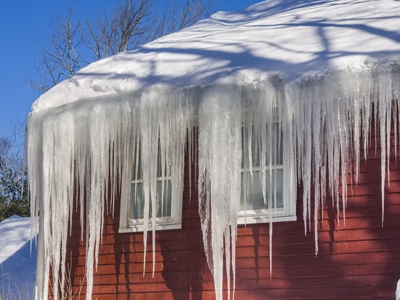Michigan is renowned for its heavy snowfall and frigid winter temperatures, making it particularly susceptible to ice dam formation. The abundant snow accumulation and fluctuating temperatures create the perfect conditions for ice dams to take hold on residential and commercial properties across the state.
As a home or business owner in Midland, you must be especially vigilant in taking preventative measures to protect your roof from the damaging effects of ice dams during winter. Fortunately, ServiceMaster Restoration by FUSON is here to offer ways to help prevent ice dams so they don’t damage your property.
What Are Ice Dams & What Kind of Damage Can They Cause?
Ice dams are like pretty but risky ice sculptures that form along the edges of roofs. They can cause big problems for homes and businesses, especially in winter.
These icy barriers can lead to the following:
- Water Damage: Ice dams can trap melting snow and rainwater on the roof, leading to leaks and water damage inside the building.
- Structural Weakness: The weight of ice dams can put excessive pressure on the roof, potentially causing structural damage and weakening its integrity.
- Safety Hazards: Falling icicles and chunks of ice from the ice dams can pose safety risks to people and property below, creating hazardous conditions around the building.
This is why you need to plan ahead of time to stop ice dams from forming on your roof.
How Do Ice Dams Form?
Ice dams form when snow on the roof melts from warm air rising in the attic, runs down to the eaves, and refreezes due to the colder temperature at the roof's edge. This repeated melting and refreezing creates a dam of ice, trapping subsequent water and forcing it under the shingles. The result? Water leaks into the property, causing damage to ceilings, walls, insulation, and other structural elements.
Several variables contribute to the likelihood of ice dam formation, including:
- Roofing Materials: The type of roofing material used, whether metal, asphalt, or wood, significantly impacts how efficiently a roof sheds heat and snow. Different materials can retain heat differently, affecting the rate at which snow melts and refreezes, potentially leading to ice dam formation.
- Snow Loads: The amount of snow accumulation on a roof, known as snow load, is a crucial factor in the formation of ice dams. Heavy snow loads increase the likelihood of snow melting and refreezing at the eaves, contributing to the development of ice dams.
- Temperature Fluctuations: Fluctuations in temperature within the environment surrounding the roof play a vital role in ice dam formation. Rapid temperature changes can lead to uneven melting and refreezing of snow, creating ice dams along the roof's edge.
During winter, lots of things can cause ice dams on roofs. The type of roof, how much snow is on it, and temperature changes all greatly affect ice dam formation. It's important to take action to protect your roof from ice dams by understanding and dealing with these factors. This way, you can keep your roof strong and safe even when winter in Midland is at its worst.
Preventing Ice Dams: Essential Steps for Property Owners
You can take several steps to prevent the formation of ice dams on your roof. These steps are crucial in safeguarding properties and maintaining the integrity of roofs during the winter months.
Prevent ice dams by:
- Improving Insulation: Proper insulation helps maintain a consistent temperature across the roof, preventing snow from melting and refreezing at the eaves. This reduces the likelihood of ice dam formation.
- Promoting Ventilation: Ensuring effective ventilation in the roof space helps expel warm air and replace it with cooler outside air, further preventing the conditions that lead to ice dam formation.
- Snow Removal with Roof Rakes: Roof rakes can aid in snow removal, particularly after heavy snowfall, preventing excessive snow accumulation and reducing the potential for ice dams.
- Clearing Gutters: Clearing gutters of debris is crucial to allow proper drainage, preventing water from backing up and forming ice dams. This is important in maintaining a free water flow off the roof.
- Preventing Heat Loss: You can help prevent heat loss by sealing air leaks and ensuring adequate attic insulation. This helps maintain a consistent temperature on the roof, reducing the risk of ice dam formation.
By implementing these preventative measures, you can better protect your home or business from the damaging effects of ice dams during the winter.
ServiceMaster Restoration by FUSON is Your Partner in Snow & Ice Damage Restoration
Even with the best preventative measures, ice dams can still wreak havoc on properties. In the event of damage caused by snow and ice, ServiceMaster Restoration by FUSON stands ready to provide expert restoration services. Whether it's water damage, structural repairs, or mold remediation, our team has the expertise and resources to restore your property to its pre-damage condition.
The dangers of ice dams are real, but with the right prevention, you can minimize the risks and protect your home and business from potential harm. Understanding how ice dams form and taking proactive steps to prevent their occurrence helps ensure a safe and secure environment, even in the harshest winter conditions.
For exceptional property damage restoration service, call (989) 200-5126 to get started!


